2010 Polaris 700 & 600 RMK Review

Polaris delivers range and versatility
If you are trying to figure out where Polaris‘ 700 RMK belongs, you are not alone. As for the Snowmobile.com Mountain Team, we know; it fits nicely in our hands and on a sick mountain with a dozen feet or more of powder. And, if you can’t afford an 800 and do not want to ride a 600, then the 700 RMK is your ticket to powder heaven. In fact, when dialed to the max, and if ridden like it was Earth’s last day, the 700 will give you an 800 day; it is that strong. And we will argue that as if we were Bill O’Reilly.
Engine Type:Horizontal In-line
Cylinders:2
Engine Stroke:2-Stroke
Valve Configuration:Reed Valve
Displacement:599 / 36.6
Starter:Pull
Turbocharged:No
View Full SpecAt the model-year 2010 photo shoot this past March, Polaris announced it was dropping the 700 RMK. We at Snowmobile.com could see the wisdom – the financial wisdom – behind the decision. But, being 700 RMK fans, we were rather miffed. We could understand that the national economy was spiraling down, snowmobile sales were dismal and the 700 RMK builder chose to widen the spread between its 600 and 800.
Guess what? Polaris dealers pounced hard on the manufacturer, forcing a reversal on that decision. As it now stands, the 700 fills a price-point and horsepower level between the 600 and 800 RMK. The 700 will be a base model 155 RMK, not dressed in Dragon trim and attire and will sell for $9,799 US / $11,999 CA.
The Dragon concept first rolled out on Polaris’ 700 motor. That first year 700 Dragon — three model-years ago — was a hit for Polaris, though it lacked displacement. OK, we know that you are saying, we, the mountain rider, mostly dwell in an 800cc world. Yet, no one will dismiss the fact the 700 RMK earned mountain rider respect for being a street fighter, all heart and soul. Its smaller motor does not give small performance.
The motor, a 140-plus horsepower Cleanfire Injected motor with two injectors per cylinder, is in our opinion, underrated. The motor’s displacement is a true 700cc with a bore and stoke of 81x68mm respectively. The difference in displacement between the 700 RMK and 800 RMK is minimal at just 95cc.
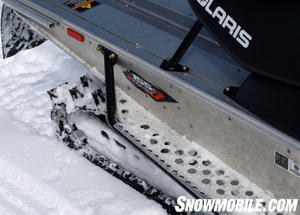 The RMK floorboard helps evacuate snow for strong running in powder.
The RMK floorboard helps evacuate snow for strong running in powder.
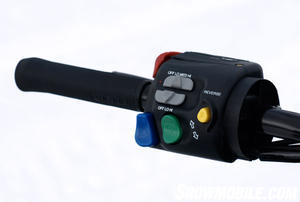 Simply push the yellow “PERC” button to engage electronic reverse.
Simply push the yellow “PERC” button to engage electronic reverse.
Like the 800, the 700 RMK has Polaris’ deep-powder specific IQ front suspension and spindles, and on the hood and cowling the RMK pre-filter intake system.
Estimated dry weight for the 7-oh-oh 155er is 486 pounds. Like the 800 RMK, it has the tall and narrow freestyle seat, digital multi-function gauges and PERC, Polaris’ electronic reverse and Ryde FX shocks on all corners.
The 700 RMK uses Polaris’ P-85 drive clutch and the P-2 driven. Stopping power is supplied by Polaris’ Phantom hydraulic brake.
From riding previous years’ 700 RMKs, the Series 5.1 track with 2.4-inch paddles kept the 700 RMK alive and assertive in the deep snow. Gripper skis dialed in our East and West moves. The Grippers’ center-to-center widths range from 39- to 41-inches. Like all RMKs, the 700 has superb ergonomics and balance, giving riders the means to master the nastiest sidehills and thickest tree-infested mountains. Though the 700 weighs as much as its 800 sibling (RMK 155), its balance defies the weight. It truly does, without argument, feel much lighter than what it is.
We applaud Polaris for the RMK tunnel, which features an integrated heat exchanger that allows coolant to dump its heat through a thin wall on top and inside the tunnel. This is a smartly engineered —and weight saving — concept.
If we were buying an RMK, the choice would be difficult. The 700 will fool you as it behaves like an 800. The 700 motor is wicked-strong for its displacement and is cheaper to purchase, leaving some cash for an extra ride, or some Polaris accessories. However, the RMK chassis is heavy by today’s mountain standards. So, if power-to-weight is your concern, then the 800 RMK may be the way to go. Tough call.
RMK 600 Version
The 600 RMK comes only in Polaris’ RMK emblem; like the 700, no Dragon package here. The 600 spins either the 144 Series 4 track with two-inch lugs, or the 155 Series 5.1 track with 2.4-inch lugs.
The 600 has Polaris’ Cleanfire fuel-injected motor that produces 120 horsepower. The twin-cylinder two-stroke motor has a displacement of 599cc with a bore and stroke of 77.25mm by 64mm.
Suspension duties are handled by the famous IQ suspension up front with Ryde FX shocks on the two corners and the well-tamed RMK rear skid, also coupled with Ryde FX shock.
Through the drivetrain, the 600 RMK uses Polaris’ P-85 drive clutch and the P-2 driven. The Phantom hydraulic brake brings the two clutches to a halt.
Polaris did not skimp-out on the 600 RMK by making it bare. It comes with pre-filter air-intakes, lightweight rails on the RMK-specific rear skid and Gripper skis up front with adjustable ski widths ranging from 39- to 41-inches center-to-center. A mountain strap and J-hooks on the handlebars are standard.
Since the 600 RMK first rolled out in the new RAW chassis, we have been fond of this powder hound. We believe the 600 has the oomph to spin a 155 with taller lugs as we prefer tall lugs to haul sled and rider over backcountry terrain. The Series 5.1 track with 2.4-inch lugs is our preference. Lest we forget, the 600, like 700, also has the RAW chassis integrated heat exchanger.
The 600’s only weakness is heft. Polaris needs to shave weight off its RAW chassis to prove to the public that its chassis is indeed RAW.
Wrap Up
Are these two RMKs entry level sleds? Yes and not so yes. Are these serious boondocking sleds? Yes. Will they run with an 800 RMK? The 600 will not. The 700? Well, yes. And that depends on rider skill and how small-framed a boy you are.
We can say, with no hesitation and no apology, the 700 RMK stacked, racked and packed next to an 800 RMK of equal track length and will match it in most gun fights. Yes, the larger displacement will win when the pulls are arduous, long, steep and deep. But in close contact fighting, the sparring, in most cases, will be equal.
Good for Polaris deciding — late, though it may be — to hold on to the RMK 700, but, we’d like to see Polaris add premium shocks, ice-scratchers and Pro-Taper handlebars to the hot rod sleeper — maybe as an early-buy incentive.
For the 700 and 600 RMKs, the handlebars and seat are exceptional for mountain maneuvering and transitioning from sitting to standing. The runningboards for these two have ample traction and smartly clean snow and ice. But, Polaris would do well by adding some width to the boards as we have missed the boards at times.
The RMKs have finesse; their superb balance makes them seem deceivingly light. And here is our loudly sung hymn, the RMKs’ behind-and-under-the-motor steering post gives the RMK excellent poise on the mountain. It’s our personal opinion that the RMK handlebar rotation is correct for sidehilling.
2010 Polaris 700 & 600 RMK Specs
| 2010 700 Polaris RMK 155 | 2010 600 Polaris RMK 155 | |
| Engine | Polaris Liberty 700cc, liquid-cooled twin; Cleanfire injection; single exhaust | Polaris Liberty 600cc, liquid-cooled twin; Cleanfire injection; single exhaust |
| Horsepower | 140-estimated | 120-estimated |
| Drive | P85 drive with P2 secondary | P85 drive with P2 secondary |
| Front Suspension | IQ RMK Double Wishbone Adjustable; 9-in travel; RydeFX shocks | IQ RMK Double Wishbone Adjustable; 9-in travel; RydeFX shocks |
| Rear Suspension | RMK parallel rail slide; 15.5 inches travel; RydeFX shock on front arm and RydeAFX shock on rear arm | RMK parallel rail slide; 15.5 inches travel; RydeFX shock on front arm and RydeAFX shock on rear arm |
| Length | 129.0 in | 129.0 in |
| Height | 49.5 in | 49.5 in |
| Width | 46.5 in | 46.5 in |
| Ski Stance | 39-41.0 in | 39-41.0 in |
| Track | 15x155x2.4 Series 5.1 | 15x155x2.4 Series 5.1 (Also available with 144 track) |
| Weight | 486 lb | 484 lb |
| Fuel Capacity | 11.5 US Gal | 11.5 US Gal |
| MSRP | $9,799 | $9,199 |
2010 Polaris RMK, Dragon & Assault Review
2010 Polaris Turbo LX Review



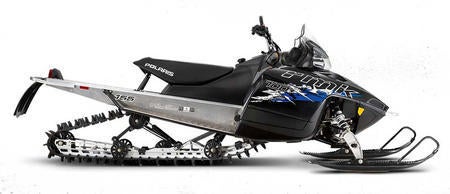
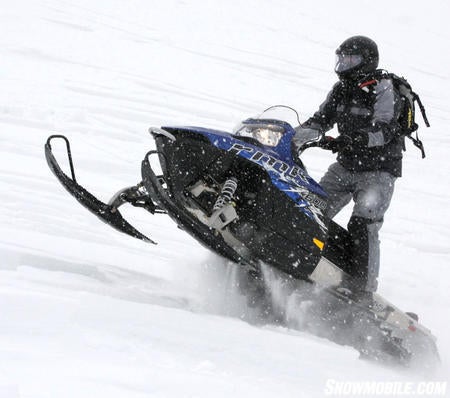
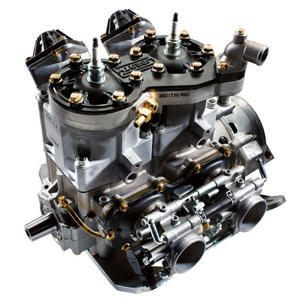
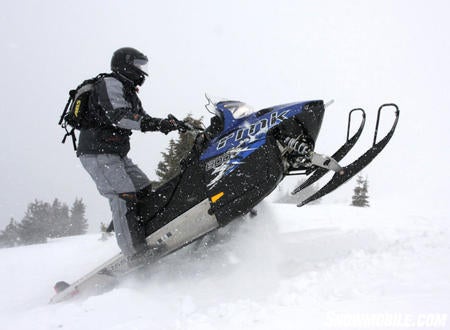

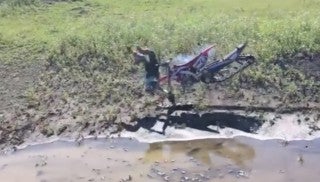
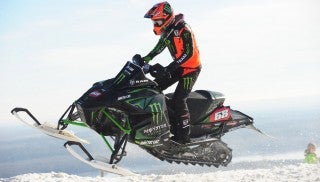


 Your Privacy Choices
Your Privacy Choices